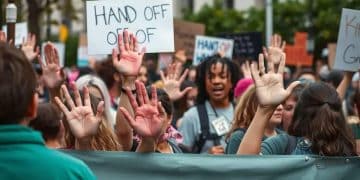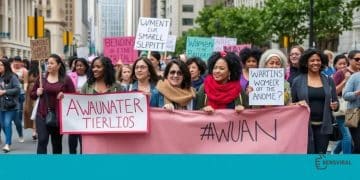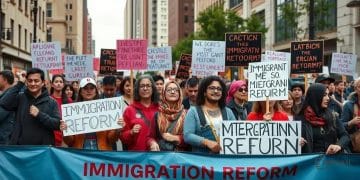Women’s rights advocacy and mobilization efforts: a call to action
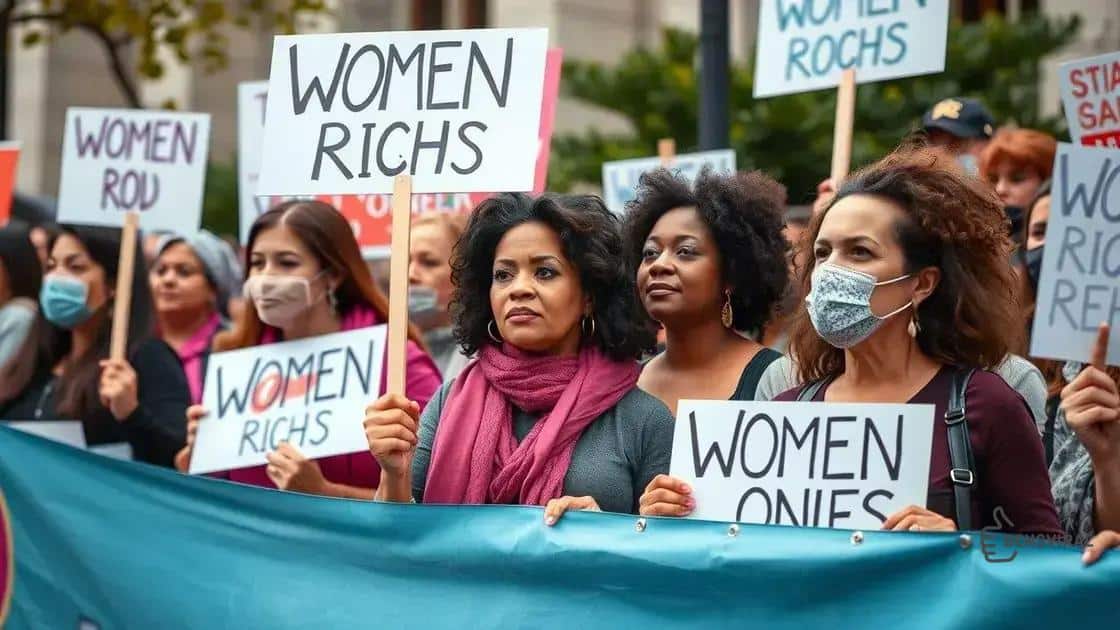
The impact of social media on women’s rights is significant, as it enhances awareness, builds supportive communities, and drives advocacy campaigns that can lead to real-world policy changes.
Women’s rights advocacy and mobilization efforts have become crucial in the fight for equality and justice across the globe. Have you wondered how these movements shape our daily lives and communities? Let’s dive into this important topic.
History of women’s rights movements
The history of women’s rights movements is a rich tapestry woven with struggles, triumphs, and perseverance. It showcases the evolution of women’s roles in society and their fight for equality.
Throughout the centuries, women have banded together, challenging societal norms that restricted their freedoms. Their dedication laid the groundwork for significant changes in laws and attitudes towards women’s rights.
Early Movements
The quest for women’s rights gained visibility in the 19th century, particularly during the suffragette movement. Women like Elizabeth Cady Stanton and Lucretia Mott organized the Seneca Falls Convention in 1848. This event marked a pivotal moment in the push for women’s voting rights.
- Formation of the National American Woman Suffrage Association (NAWSA)
- Advocacy for property and educational rights
- Promotion of women’s roles in broader social reforms
As time progressed, the movement expanded beyond voting rights to address a wide range of issues including employment, education, and reproductive rights.
The 20th Century and Beyond
By the early 20th century, women had begun to see notable progress. The passage of the 19th amendment in 1920 granted women the right to vote in the United States. This victory inspired further activism focused on other rights.
During the 1960s and 70s, the second wave of feminism challenged gender roles extensively. Women advocated for legal equality, reproductive justice, and against workplace discrimination. The establishment of organizations such as NOW (National Organization for Women) played a crucial role in advancing these causes.
- Campaigns against sexual harassment
- Access to contraceptive methods
- Equality in the workplace
- Representation in politics
Today, the impact of these movements resonates globally, inspiring new generations to advocate for women’s rights and equality.
Key figures in women’s rights advocacy
The key figures in women’s rights advocacy have paved the way for significant change over the years. Their contributions have shaped the landscape of gender equality and inspired countless individuals to join the fight.
Many strong leaders have emerged throughout history, each adding their unique voice to the movement. From early suffragists to contemporary activists, these figures have made lasting impacts in their pursuit of equality and justice.
Historical Pioneers
In the 19th century, individuals like Sojourner Truth and Susan B. Anthony stood at the forefront of the struggle for women’s rights. Sojourner Truth gave her famous “Ain’t I a Woman?” speech in 1851, highlighting the intersection of race and gender in the fight for rights. Meanwhile, Susan B. Anthony was a prominent leader in the suffrage movement, tirelessly campaigning for women’s right to vote.
- Sojourner Truth: A powerful speaker and abolitionist.
- Susan B. Anthony: A key organizer for women’s suffrage.
- Emmeline Pankhurst: Pioneer in the British suffrage movement.
These pioneers laid the groundwork for future generations, pushing against societal norms and advocating for change, despite facing significant opposition.
Modern Influencers
As the women’s rights movement evolved, so did its leaders. In the second wave of feminism during the 1960s, figures such as Betty Friedan and Gloria Steinem emerged. Friedan’s book, “The Feminine Mystique,” challenged traditional gender roles, while Steinem co-founded the National Women’s Political Caucus, advocating for women’s representation in politics.
These leaders highlighted issues such as workplace equality, reproductive rights, and sexual freedom, ensuring the movement’s relevance in changing times. Their persistent efforts mobilized millions and led to significant legislative progress.
- Betty Friedan: Author and feminist icon.
- Gloria Steinem: Journalist and activist for women’s rights.
- Ruth Bader Ginsburg: Champion for gender equality in law.
By amplifying women’s voices and advocating for justice, these modern figures have propelled the movement into new arenas, demonstrating that the fight for women’s rights is ongoing and dynamic.
Current challenges in women’s rights
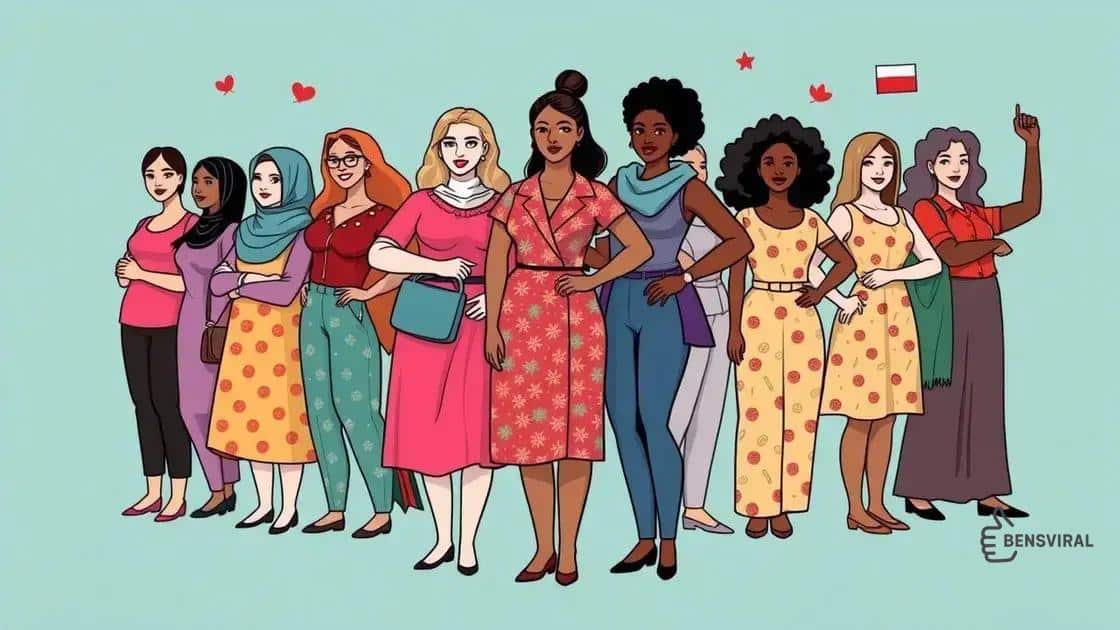
Understanding the current challenges in women’s rights is crucial to continue making progress toward equality. Despite significant advancements, many obstacles remain that hinder the fight for women’s rights globally.
Today, women continue to face inequality in various areas, including employment, health, and personal safety. The fight for gender equality is far from over, and new issues constantly arise that require vigilance and action.
Economic Equality
One pressing challenge is the persistent wage gap between men and women. Women often earn less than their male counterparts for the same work. Additionally, women are frequently concentrated in lower-paying jobs and sectors, which limits their economic independence.
- Unequal pay for equal work.
- Limited access to high-paying job sectors.
- Discrimination in hiring and promotions.
Efforts to improve economic opportunities for women are ongoing, but many barriers still exist that perpetuate inequality.
Health and Reproductive Rights
An essential area of concern involves women’s health and the right to make choices about their own bodies. In many regions, access to healthcare services, including reproductive health care, is limited. This affects not only overall health but also decision-making power over personal lives.
Access to resources such as contraception and safe abortion services remains contested in various parts of the world. These issues highlight the need for policies that respect women’s autonomy.
- Access to reproductive healthcare services.
- Education on reproductive rights.
- Combating stigma and misinformation.
Ensuring that women can make informed choices is vital to their empowerment and health.
Gender-Based Violence
Another critical challenge is the prevalence of gender-based violence, which severely impacts women’s rights and safety. This includes domestic violence, sexual harassment, and human trafficking. Cultural attitudes often contribute to the normalization of violence against women, making it difficult to combat.
Addressing these issues requires strong legal frameworks and social support systems to protect women and create safe environments.
- Raising awareness of gender-based violence.
- Strengthening legal protections for victims.
- Promoting community support programs.
Progress is being made, yet continued advocacy and action are essential to overcome these challenges and ensure that women’s rights are recognized and upheld.
Mobilization strategies for advocacy
Mobilization strategies for advocacy play a crucial role in advancing the women’s rights movement. Effective mobilization can bring together individuals and organizations to create a powerful force for change.
These strategies often combine grassroots efforts, community engagement, and digital tools to amplify voices and drive action. By utilizing various methods, advocates can effectively raise awareness and promote their causes.
Grassroots Organizing
Grassroots organizing serves as the foundation for many advocacy campaigns. This approach encourages local communities to take action on issues that directly affect them. By engaging people at the community level, movements can gain traction and ensure that the voices of those most impacted are heard.
- Creating local coalitions to strengthen community ties.
- Hosting workshops to educate and empower individuals.
- Encouraging community members to share their stories and experiences.
By fostering a sense of ownership among participants, grassroots efforts can mobilize significant support for women’s rights initiatives.
Leveraging Social Media
In today’s digital age, social media has become an essential tool for advocacy. Platforms like Twitter, Facebook, and Instagram allow advocates to reach a broader audience quickly. Campaigns can go viral, generating awareness and rallying support for causes in real-time.
Social media can also provide a platform for marginalized voices, giving them the opportunity to share their experiences and advocate for change.
- Creating hashtags to unite supporters around a common cause.
- Sharing informative content and resources to educate the public.
- Engaging followers through interactive content, like live Q&As.
Effective use of social media allows movements to build momentum and engage younger audiences who are key to the advocacy efforts.
Collaborating with Organizations
Collaboration between various organizations can amplify advocacy efforts. By partnering with local, national, and international groups, advocates can share resources, expertise, and networks. This solidarity can strengthen campaigns and provide a united front on women’s rights issues.
Joint initiatives can also help reach diverse populations and broaden the impact of advocacy efforts.
- Identifying shared goals and objectives with partner organizations.
- Co-hosting events and campaigns to maximize resources.
- Cross-promoting activities and reaching wider audiences.
A collaborative approach fosters a strong support network that can address the complexities of women’s rights advocacy effectively.
Impact of social media on women’s rights
The impact of social media on women’s rights has been transformative in recent years. Platforms like Twitter, Facebook, and Instagram have reshaped how advocacy unfolds, allowing for a new wave of activism.
Through social media, women’s voices can be amplified, reaching a global audience almost instantaneously. This connectivity fosters solidarity and raises awareness about various issues affecting women’s rights.
Spreading Awareness
Social media is a powerful tool for spreading awareness of women’s rights issues. Activists can share stories, articles, and statistics that highlight gender inequality and violence against women. This information can quickly go viral, prompting public discussions and mobilizing support.
- Utilizing hashtags to create trends and unite advocates.
- Sharing eye-catching visuals and personal stories for greater engagement.
- Providing informational resources and guides for followers.
Posts can invite followers to participating events, sign petitions, or support organizations working towards women’s rights.
Connecting Communities
Social media connects diverse communities, allowing individuals from different backgrounds to come together under common goals. Women can form online support groups that foster discussion about experiences and challenges.
These platforms create spaces where marginalized voices can be heard and recognized, helping to challenge stereotypes and combat discrimination.
- Facilitating online forums for sharing experiences and advice.
- Building networks of support and mentorship among women.
- Creating spaces for activists to collaborate on initiatives.
Through these connections, social media can empower women to advocate for their rights and inspire others to do the same.
Driving Change
Moreover, social media can drive real-world change by encouraging grassroots movements and campaigns. Many successful women’s rights campaigns have utilized social media strategies to mobilize support and influence policy.
By creating online petitions, sharing impactful videos, and organizing virtual events, advocates have increased visibility for critical issues and pressured decision-makers to act.
- Launching campaigns that highlight specific issues, like pay equity or reproductive rights.
- Engaging influencers to reach broader audiences.
- Encouraging mass participation in protests and events both online and offline.
The ability to instantly rally support for a cause signifies a critical evolution in how women’s rights are advocated.
FAQ – Frequently Asked Questions about the Impact of Social Media on Women’s Rights
How has social media changed women’s rights advocacy?
Social media has enabled greater awareness and mobilization for women’s rights, allowing advocates to reach wider audiences quickly.
What role does social media play in spreading awareness of women’s issues?
Social media serves as a platform for sharing information, stories, and statistics that highlight gender inequalities and injustices.
Can social media help build communities for women?
Yes, social media connects women from diverse backgrounds, fostering supportive communities where they can share experiences and advice.
How do online campaigns affect policy changes regarding women’s rights?
Online campaigns can rally significant public support, pressuring policymakers to address women’s rights issues and implement necessary changes.

